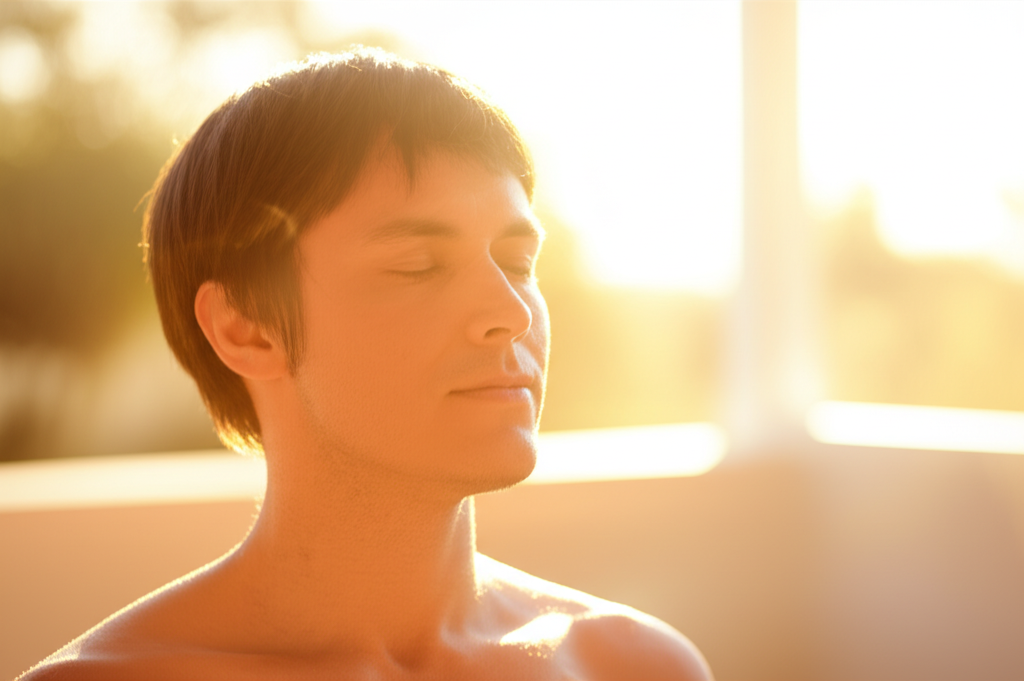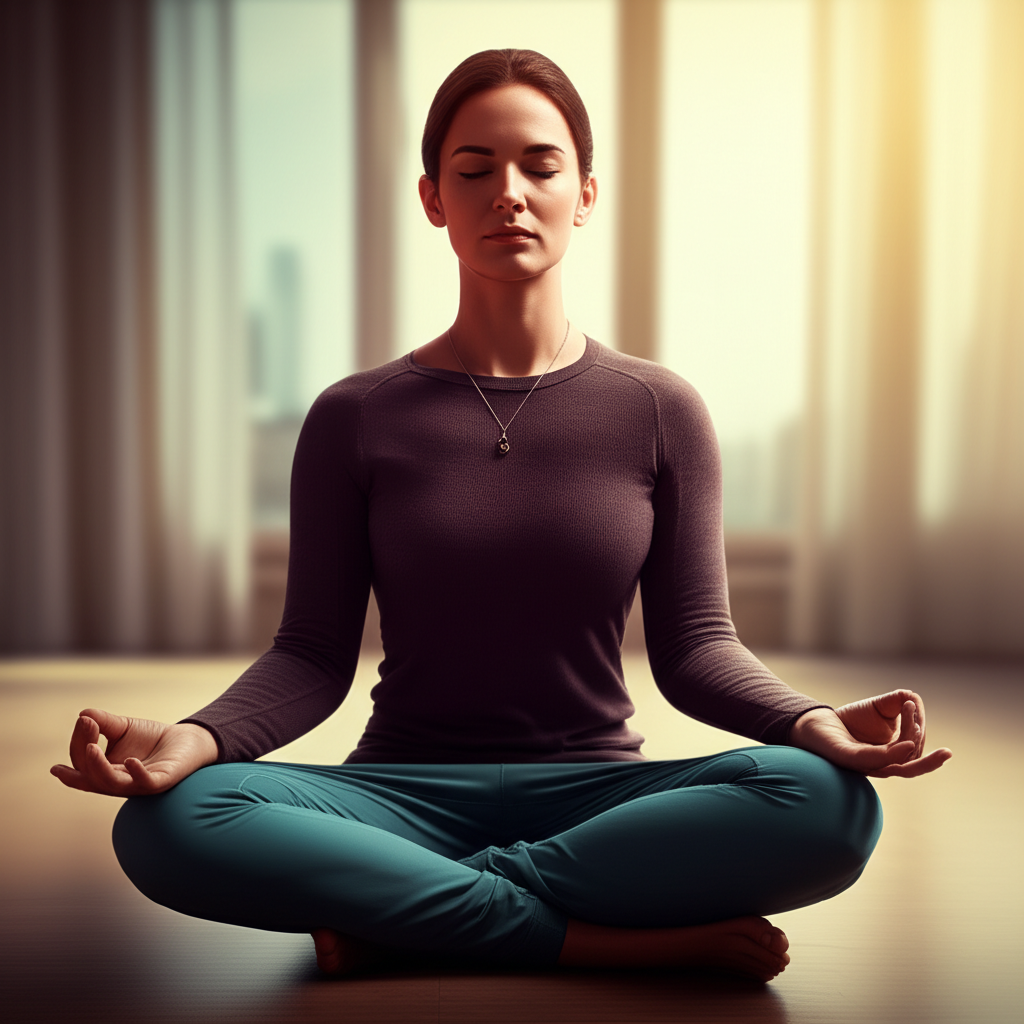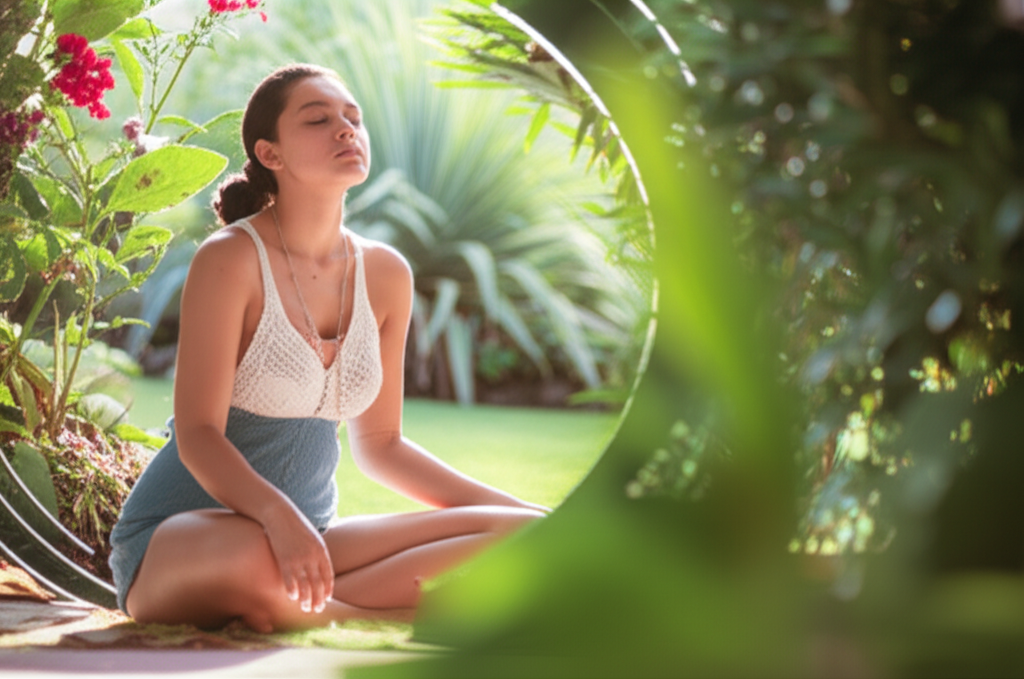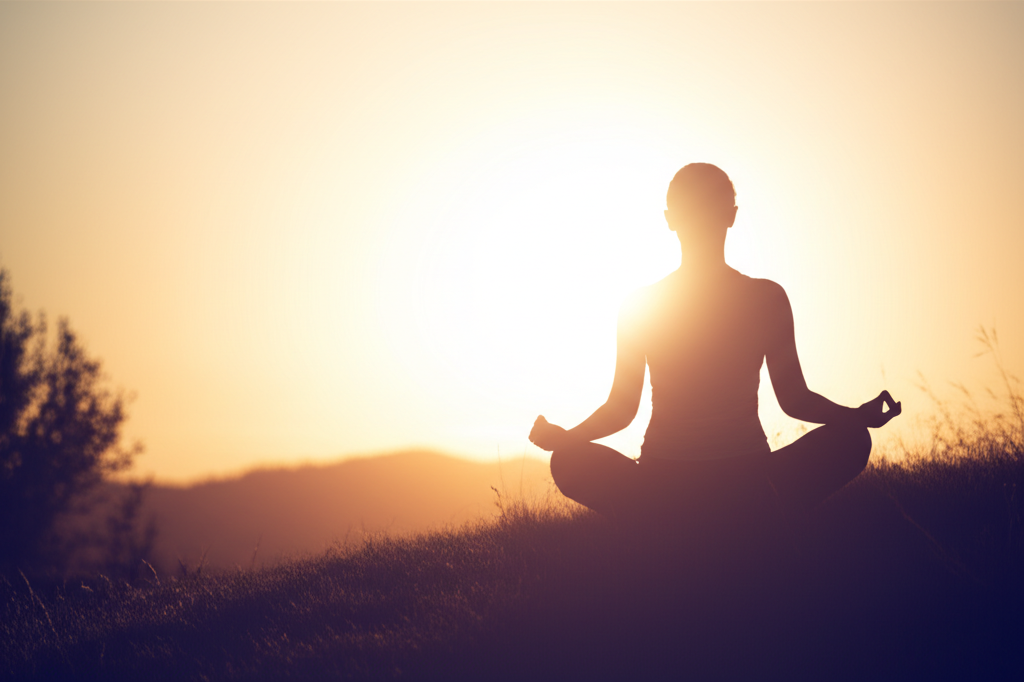Now Reading: Mindfulness: Cultivate Presence & Find Everyday Peace
-
01
Mindfulness: Cultivate Presence & Find Everyday Peace
Mindfulness: Cultivate Presence & Find Everyday Peace
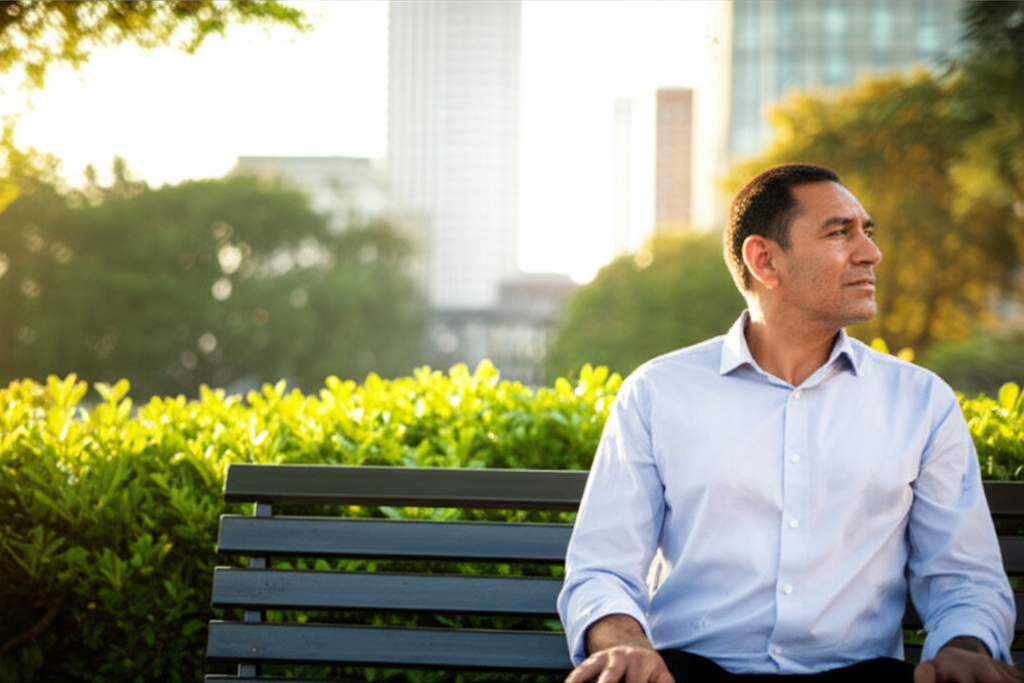
In our modern world, life often feels like a non-stop express train, hurtling us from one obligation to the next. It’s easy to feel overwhelmed, stressed, and disconnected from ourselves and the precious moments we’re living. Perhaps you find your mind constantly racing, replaying past events, or worrying about the future, leaving little room for peace in the present.
What if there was a simple, accessible practice that could help you step off that train, even for a moment, and find calm amidst the chaos? What if you could cultivate an inner sanctuary, no matter what’s happening around you, perhaps by simply focusing on your breath for a moment? That’s where mindfulness comes in, a powerful **stress reduction technique**.
As your compassionate guide, I’m here to introduce you to the transformative power of mindfulness. It’s an empowering practice that doesn’t require hours of dedication or special equipment, but simply a willingness to be present. In this article, we’ll demystify what mindfulness truly is, explore its profound, evidence-based benefits for your mental health and everyday well-being, share practical exercises you can start today, and debunk common myths that might be holding you back from truly embracing **mindful living tips**.
What Exactly Is Mindfulness? Unlocking Present Moment Awareness
At its core, mindfulness is a fundamental human ability we all possess. It’s the capacity to be fully present and aware of where we are and what we’re doing, without being overly reactive or overwhelmed by what’s going on around us. Think of it as waking up from “autopilot” mode and stepping into conscious awareness.
The renowned pioneer of mindfulness in the West, Jon Kabat-Zinn, defines it as “paying attention on purpose, in the present moment, and non-judgmentally.” Let’s gently break that down:
- On Purpose: It’s an intentional act. You choose to bring your awareness to something, whether it’s your breath, a sound, or the feeling of your feet on the ground. It’s an active decision to tune in.
- In the Present Moment: Mindfulness is anchored to what’s happening right here, right now, rather than dwelling on the past or fretting about the future. It’s about truly experiencing this very moment, as it unfolds.
- Non-Judgmentally: This is a crucial and often misunderstood aspect. It means observing your thoughts, feelings, and sensations without labeling them as “good” or “bad,” “right” or “wrong.” You simply notice them with an attitude of open curiosity and acceptance. Imagine you’re watching clouds drift across the sky. Some might be dark, some fluffy, some shapeless. You simply observe them as they are, without saying, “Oh, that dark cloud is bad!” or “That fluffy cloud is good!” In the same way, when a thought like ‘I’m not good enough’ or a feeling like ‘frustration’ arises, mindfulness encourages you to simply notice it – ‘Ah, there’s a thought about not being good enough,’ or ‘Here’s the feeling of frustration’ – without getting caught up in judging yourself for having it or trying to push it away. It’s about creating a little space and observing with gentle curiosity, knowing that thoughts and feelings are temporary, like those passing clouds.
It’s not about emptying your mind or achieving a state of blissful calm (though calm often follows). It’s about developing an attuned awareness to your experience, moment by moment. It’s an innate capacity that anyone can cultivate and strengthen, leading to greater inner peace and resilience.
Mindfulness vs. Meditation: Clarifying the Connection for Mindful Living Tips
It’s easy to confuse mindfulness with meditation, and while they’re deeply connected, they’re not quite the same thing. Think of them as two sides of a beautiful coin:
- Mindfulness: This is the quality of mind or a state of being. It’s about living with present-moment awareness, whether you’re eating, walking, talking, or simply breathing. It’s a way of approaching life with open, gentle attention.
- Meditation: This is a formal practice or a tool used to cultivate and strengthen your mindfulness muscle. Just as you might go to a gym to strengthen your physical muscles, you engage in meditation exercises to enhance your capacity for present-moment awareness and bring more **mindful living tips** into your daily routine.
The beauty is that you can practice mindfulness throughout your entire day, even if you don’t engage in formal meditation sessions. Small, mindful pauses woven into your daily routine can make a significant difference. Meditation, like Mindfulness-Based Stress Reduction (MBSR) programs, can deepen this skill, but it’s not a prerequisite for experiencing the profound benefits of mindfulness in your everyday life.
The Profound Benefits of Cultivating Presence for Your Well-being (Beyond Stress Reduction)
Mindfulness isn’t just a feel-good trend; it’s a powerful collection of **stress reduction techniques** and **mindful living tips** backed by a growing body of scientific research demonstrating its profound positive impacts on various aspects of our well-being and overall quality of life.
For Mental & Emotional Health:
- Stress and Anxiety Reduction: Numerous studies show mindfulness practices can significantly lower stress levels, reduce symptoms of anxiety, and even decrease cortisol (the stress hormone) in the body. By becoming aware of stress signals without immediate reactivity, you can choose a calmer, more deliberate response.
- Improved Emotional Regulation & Resilience: Mindfulness fosters the ability to observe difficult emotions without being swept away by them. It helps you create a ‘space’ between a challenging event and your reaction, allowing you to respond in healthier, more adaptive ways. This builds true mental fortitude and resilience, helping you navigate life’s inevitable ups and downs with grace.
- Reduced Rumination & Negative Thought Patterns: If your mind often gets stuck in cycles of worrying about the past or future, mindfulness can gently help you break free. By kindly returning your attention to the present, you interrupt these unhelpful thought loops, fostering a sense of inner peace.
- Increased Self-Awareness and Self-Compassion: As you practice observing your inner landscape without judgment, you gain a deeper understanding of your thoughts, feelings, and behavioral patterns. This awareness naturally leads to greater kindness, acceptance, and self-compassion towards yourself – a truly foundational aspect of well-being.
- Better Sleep Quality: A calmer, less agitated mind is often a prerequisite for restful sleep. Mindfulness helps quiet the mental chatter that often keeps us awake, aiding in falling asleep faster and improving sleep continuity, leading to more energized days.
For Cognitive Function & Mental Clarity:
- Enhanced Focus, Attention, and Concentration: Training your mind to stay present, even for short periods, directly improves your ability to focus, sustain attention, and concentrate on tasks. This is incredibly beneficial in our distraction-filled world.
- Improved Memory & Cognitive Flexibility: Research indicates that regular mindfulness practice can lead to benefits in working memory and enhance cognitive flexibility – your brain’s ability to adapt thought patterns and problem-solve effectively, fostering **mental clarity**.
For Overall Life Quality & Everyday Peace:
- Deeper Connections & Relationships: When you are fully present with others, you listen more attentively and engage more authentically, leading to more meaningful and fulfilling interactions. It truly elevates your relationships.
- Greater Appreciation & Joy: Mindfulness helps you notice and savor the simple pleasures in daily life – the warmth of a cup of tea, the sound of birds, the taste of your food. This cultivates a profound sense of gratitude and joy that’s always available.
- Coping with Challenges: Instead of being overwhelmed by difficulties, mindfulness equips individuals with practical tools to navigate challenging experiences with greater calm, less reactivity, and more wisdom. It helps you develop a resourceful approach to life’s inevitable ups and downs, building your inner **resilience**.
Simple Mindfulness Exercises for Everyday Peace & Accessible Self-Care
Ready to start cultivating presence and embrace some **mindful living tips**? Here are some simple, accessible self-care techniques, both formal and informal, that you can gently integrate into your daily routine, no special equipment needed!
Getting Started with Formal Practices (Beginner-Friendly Stress Reduction Techniques):
- Mindful Breathing: This is often the gateway to formal practice. Find a comfortable position, gently close your eyes (or soften your gaze), and bring your attention to the sensation of your breath. Notice the inhale and exhale, perhaps the gentle rise and fall of your belly or chest. When your mind wanders (which it will, and that’s perfectly normal!), simply acknowledge the thought and gently guide your attention back to your breath. Even 3-5 minutes can make a remarkable difference. This is often called a “3-minute breathing space.”
- Basic Body Scan Meditation: Lie down or sit comfortably. Gently bring your attention to different parts of your body, starting from your toes and slowly moving upwards. Notice any sensations – tingling, warmth, coolness, pressure – without judgment. Just observe what’s there with open curiosity. This helps ground you deeply in your physical experience.
- Guided Meditations: For many beginners, guided meditations are a wonderful starting point. They offer instructions and gentle prompts, making it easier to stay focused and less daunting. Reputable apps like Calm, Headspace, and Insight Timer offer a vast library of guided sessions for various purposes and durations, making **stress reduction techniques** easy to access.
Integrating Mindfulness into Daily Life (Informal Practices & Mindful Living Tips):
These informal practices are truly where mindfulness shines as an **accessible self-care technique** for busy individuals. They can be woven into almost any everyday activity, helping you find **everyday peace** in unexpected moments:
- Mindful Eating: Before you take a bite, pause. Notice the colors, shapes, and textures of your food. As you eat, pay full attention to the taste, smell, and sensations in your mouth. Notice when you feel hungry and when you feel satisfied. This transforms a mundane act into a rich, sensory experience.
- Mindful Walking: Whether you’re walking to your car or taking a stroll, bring your attention to the sensations of your feet touching the ground, the movement of your legs, and the rhythm of your breath. Notice the sights and sounds around you without getting lost in thought. It’s a wonderful way to cultivate **present moment awareness**.
- The 5-4-3-2-1 Technique: This is a powerful grounding exercise, especially helpful when feeling overwhelmed or anxious. Take a deep breath and then gently notice:
- 5 things you can see (e.g., a chair, a plant, your hand)
- 4 things you can touch (e.g., your clothes, the floor, your hair)
- 3 things you can hear (e.g., distant traffic, your breath, birds)
- 2 things you can smell (e.g., your coffee, a faint scent in the air)
- 1 thing you can taste (e.g., the lingering taste of your last meal, your saliva)
- Mindful Listening: When someone is speaking, truly listen without planning your response. Give them your full attention. Alternatively, consciously notice the sounds around you for a minute – distinguishing different noises without judgment.
- Single-Tasking: In our multi-tasking world, dedicate your full attention to one task at a time, whether it’s washing dishes, brushing your teeth, or writing an email. Minimize distractions and fully engage in what you’re doing. This simple shift can reduce overwhelm.
- The Mindful Pause: Before reacting to a stressful email, a challenging comment, or a frustrating situation, take a brief moment. Acknowledge the feeling, take one or two conscious breaths, and then choose your response rather than automatically reacting. This small pause can be a huge source of **resilience** and calm.
Debunking Common Mindfulness Myths (Navigating Anxiety & Building Resilience)
It’s easy to get caught up in misconceptions about mindfulness that can prevent you from even starting. As your friend and guide, let’s clear those up so you can embark on your journey to **navigating anxiety** and **building resilience** with confidence:
- Myth 1: Mindfulness is about emptying your mind.
Reality: This is one of the biggest myths! Our minds are designed to think, and thoughts will naturally arise. Mindfulness isn’t about stopping thoughts but about observing them without judgment. It’s like watching clouds pass by in the sky – you notice them, but you don’t grab onto them or try to make them disappear. You simply let them come and go, fostering a sense of spaciousness. - Myth 2: Mindfulness is just relaxation.
Reality: While mindfulness often leads to a profound sense of calm and relaxation, its primary goal is awareness and acceptance. This means being present even with discomfort, pain, or difficult emotions. It’s about learning to relate differently to these experiences, rather than trying to escape them, which paradoxically leads to deeper peace. - Myth 3: You need a lot of time or a quiet space to practice.
Reality: Not at all! As you saw with the informal practices, mindfulness can be practiced anywhere, anytime, even for a few seconds. A mindful pause in a busy office, mindful walking on a crowded street, or mindful breathing during a commute are all valid and effective practices. It truly is an **accessible self-care technique**. - Myth 4: Mindfulness is a quick fix for all problems.
Reality: Mindfulness is a skill, and like any skill, it requires consistent practice and commitment. It’s not a magic bullet that instantly eradicates all your challenges. Instead, it’s a powerful tool that, with regular application, yields profound and long-term benefits for navigating life’s complexities with greater ease and resilience. It’s a journey, not a destination. - Myth 5: Mindfulness is a religious or spiritual practice.
Reality: While mindfulness has roots in ancient Buddhist traditions, it has been widely adapted and taught in secular contexts for well-being, stress management, and mental health improvement. You don’t need to adopt any particular belief system to benefit from it. It’s a universal human capacity.
Tips for Starting & Sustaining Your Mindfulness Journey Towards Everyday Peace
As your trusted friend on this path, here are a few gentle reminders to help you begin and stick with your mindfulness journey, cultivating **everyday peace** and lasting **resilience**:
- Start Small & Be Consistent: Don’t feel pressured to meditate for an hour from day one. Even a few minutes daily – a mindful breath before starting your workday, or a mindful pause before responding to an email – is incredibly effective. Consistency is far more important than duration when fostering this new, supportive habit.
- Be Patient & Kind to Yourself: Your mind will wander. That’s just what minds do! The practice isn’t about stopping thoughts but about gently noticing when your mind has drifted and kindly returning your focus to your anchor (like your breath). This isn’t about perfection; it’s about persistent, gentle effort and self-compassion.
- Integrate into Daily Routines: Pair mindfulness with existing habits. For example, make your morning coffee a mindful experience, pay attention while brushing your teeth, or use waiting in line as an opportunity for a mindful pause. These **mindful living tips** make practice seamless.
- Explore & Experiment: There isn’t a one-size-fits-all approach. Try different exercises, explore various guided meditations, and find what resonates best with your individual needs and lifestyle. What works for one person might not work for another, and that’s perfectly okay.
- Seek Support (Optional): If you feel drawn to it, explore online resources, join a local mindfulness class, or consider a therapist trained in mindfulness-based approaches like MBSR (Mindfulness-Based Stress Reduction) or MBCT (Mindfulness-Based Cognitive Therapy).
The journey to cultivating presence is a deeply personal and profoundly rewarding one. It offers an accessible, evidence-based self-care technique for navigating everyday mental health challenges, fostering resilience, and bringing a profound sense of **everyday peace** and **present moment awareness** into your life.
So, take a deep breath, embrace the warmth of your own presence, and know that you already have everything you need within you to begin. I encourage you to take that first gentle step and experience the profound benefits of mindfulness for yourself. Your path to greater calm and well-being starts right here, right now.


